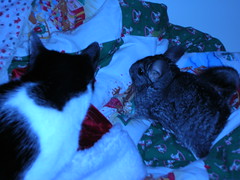Anyway, Bernard, Lily, Hyzenthlay, and Half-Pint might be interested (if they had larger intellects) to know that an extinct cousin of theirs was recently discovered which outweighed some of the dinkier automobiles on the road. To be more precise, Josephoartigasia monesi weighed about a metric tonne. (Well, based on allometric inferences, anyway -- only the skull is known.)
Wonderfully, the paper is freely available.
How close was it to my messy housemates? Reasonably close -- since they're both caviomorphs (a group named after the guinea pig genus), their shared ancestry goes back at furthest to the middle Oligocene, roughly 28 million years ago. (J. monesi itself is from the Pleistocene, roughly a million years ago.) But J. monesi is much closer another living South American rodent called the pacarana, Dinomys branickii. Basically, it's a stem-pacarana.
 Illustrations of a) Josephoartigasia monesi and b) its close living relative, the pacarana (Dinomys branickii), to scale, by G. Lecuona. A larger version is available in the paper, linked above.
Illustrations of a) Josephoartigasia monesi and b) its close living relative, the pacarana (Dinomys branickii), to scale, by G. Lecuona. A larger version is available in the paper, linked above.And it's not the only giant South American rodent. The type species of Josephoartigasia, J. magna, was a smaller giant, as were some other stem-pacaranas less close to pacaranas, like Phoberomys pattersoni (about 700kg) and Phoberomys insolita (even bigger, but poorly known). Even today, the largest rodent in the world is the South American capybara*, Hydrochoerus hydrochaeris, weighing up to 65 kg. And the pacarana itself is no slouch, at 15 kg.
South America was until recently host to a number of large-to-gigantic animals we'd find strange today. There were ground sloths; tank-like stem-armadillos called glyptodonts; ground-dwelling killer birds called phorusrhacids; the aforementioned huge caviomorphs; and two groups of hoofed mammals unrelated to any of the modern groups: notoungulates, including the hippo-like Toxodon, and litopterns, including the bizarre Macrauchenia, which looked something like a llama with the head of a tapir.
On the subject of tapirs, clearly not all of the weird South American fauna has died out. While much of it seems to have been done in by invaders from North America, some of it has continued to flourish. A couple of groups, including the opossums, Didelphis, and certain armadillos, Dasypus, have even "swum against the tide" and colonized North America from South America.
And, of course, there are the four little furballs sitting in my downstairs. Oh, maybe I'll go give them some raisins -- they are kind of cute when they hold them.
 Susan's cat, Caspian, at left, with one of her chinchillas, Bernard, at right. Photo by Susan Havens. (Not one of her best, but....)
Susan's cat, Caspian, at left, with one of her chinchillas, Bernard, at right. Photo by Susan Havens. (Not one of her best, but....)* Apparently also known as the carpincho, according to the paper. Sounds kind of rude, somehow.
Holy moley! Or should that be holy ratty?
ReplyDeleteCarpincho is used mainly in Uruguay and in my country, Argentina. Like capybara, it is derived from the Guaraní word kapi'i, which means 'grass' (capybara means "lord of the grass").
ReplyDeleteAh, thanks for the etymology. Interesting.
ReplyDelete(It sounds kind of like Mexican Spanglish for "f***ing car".)
"Holy pacarany" sounds kind of odd....
ReplyDeletetwo groups of hoofed mammals unrelated to any of the modern groups
ReplyDeleteWell, probably, but nobody has ever tried to find out (by means of phylogenetic analysis, I mean)...
Tapirs, on the other hand, are ordinary perissodactyls that survive in Asia, were common in North America till the end of the last ice age, and only turned up in SA 9 million years ago according to an SVP meeting abstract that would probably have hit the news if it had been properly published yet.
Also, there was an impact close to Argentina 3.3 Ma ago that seems to have triggered a local mass extinction, killing e. g. the borhyaenoids off before the Great American Interchange got rolling 300,000 years later.
True about it being untested, but I stand by my default, ignorant assumption.
ReplyDeleteDidn't know about the impact or tapirs coming to SA so late. (I do realize that they have a pretty wide distribution, globally.) Interesting.